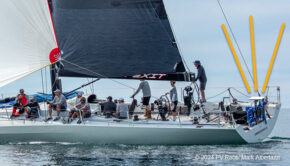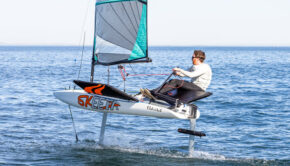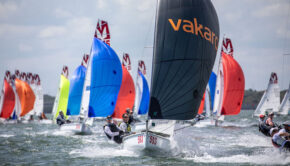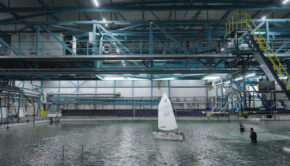Solar Powered, Kite Supported
Published on November 26th, 2021
The phrase ‘go fly a kite’ was once only a dismissive expression, but now it is powering a generation that seeks independence from fossil fuels.
The new SILENT 60 solar powered catamaran carries 42 solar panels for 17 kWp of solar energy to power two electric motors of up to 2x340kw. Backed up by a battery capacity of up to 286 kWh, the yacht can cruise efficiently with zero emissions solely on solar power for up to 100 nautical miles a day for weeks.
However, to further improve its green credentials and range, for longer crossings the first SILENT 60 is also fitted with a compact 9 or 13-sqm kite wing.
A dedicated storage locker under the foredeck houses the kite wing and all its components, including an electric winch and a short, collapsible mast.
After inflating the kite, it is released overboard to drift away on the surface of the water. Pulling on the lines launches it into the air and once it reaches the optimal flight height, it begins to trace a figure “8” in the sky and generates power to pull the yacht.
If you want to stop kiting, the automated app controls move the kite to a position right above the boat where it has the least pull on the line. From here it can be winched down electrically and collapsed over the foredeck ready for stowage.
The main advantages of a kite over a conventional sail system are that it does not throw shade on the solar panels, does not need a tall mast, and generates up to 10 times more power per square metre than a traditional sail. In addition to that it saves about 1.5 tons of weight compared to conventional rig and costs much less.
Because the SILENT boats run on renewable solar energy, the power generated by a kite easily exceeds the energy consumption of the system, so you can charge the batteries while cruising under kite power.
“We tested the performance on different headings and at wind angles of up to 40 degrees with the 9-sqm kite,” says SILENT-YACHTS’ Captain Mike Wandler. “Unlike a conventional sailing boat, the best results were directly downwind.
“Under kite power with no engines on or propellers turning, the boat speed was between 4 and 5 knots. We then switched on the electric motors drawing just 1kW each to reduce drag from the propellers and improve the flow of water over the rudders for better steering, this led to boat speeds from 6 to 7 knots over the same headings – a significant improvement on our original predictions.”
A big advantage of a kite compared to a conventional sail is, that the kite flies in much higher altitudes and therefore gets more steady and stronger winds up there. Therefore, it can already be used at low wind speeds of less than 10 knots, when it would not make any sense to hoist a sail on a sailing boat of comparable size.
As the kite rather pulls the boat than pushes it like a conventional sail, it requires good steering capabilities, which are compromised by the fact, that on a motorboat the rudder is typically pretty small and the propeller big. On a sailing boat it is the opposite.
For this reason, it is difficult to steer a motorboat that is being pulled by a kite, but by turning on the motors, and by letting them run at a low speeds of 100 rpm this problem can be solved.
But only on a SILENT Yacht it is possible to run the electric motors at such a low rpm powered solely by solar energy and without consuming fossil energy. Any conventionally powered boat would need to run the diesel motors permanently when using the kite.









 We’ll keep your information safe.
We’ll keep your information safe.